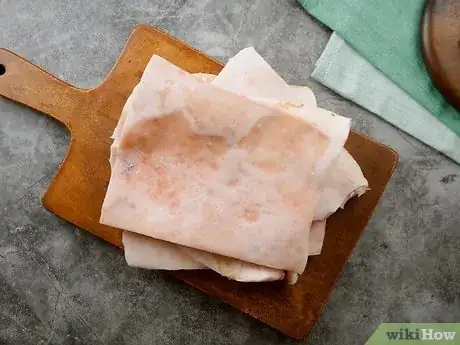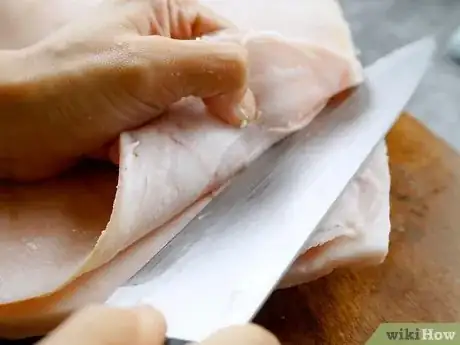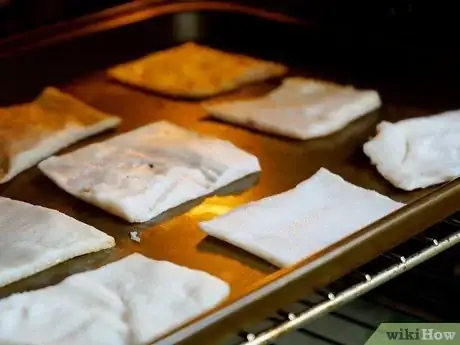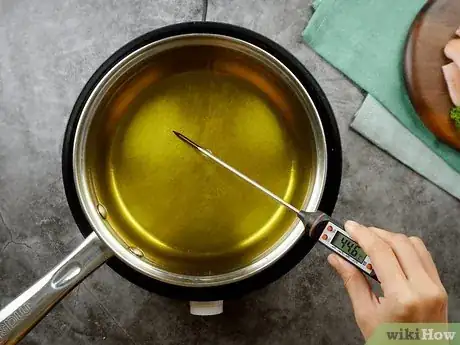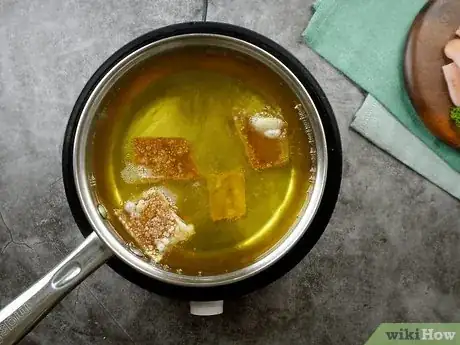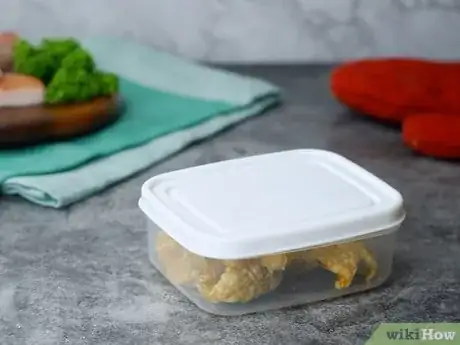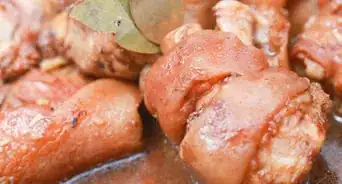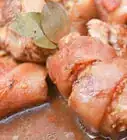This article was co-authored by wikiHow Staff. Our trained team of editors and researchers validate articles for accuracy and comprehensiveness. wikiHow's Content Management Team carefully monitors the work from our editorial staff to ensure that each article is backed by trusted research and meets our high quality standards.
There are 7 references cited in this article, which can be found at the bottom of the page.
The wikiHow Culinary Team also followed the article's instructions and verified that they work.
This article has been viewed 101,462 times.
Learn more...
Many cooks and butchers discard pork skin as a waste product. However, this overlooked cut of meat is delicious when prepared properly. First, trim any fat away from the pork skin and cut it into small pieces. Next, dehydrate the skins in the oven. Once they’re hard and tough, fry them in a quality oil until they’re large and puffy. Serve these crispy, decadent skins with your favorite blend of salt, pepper, and spices.
Ingredients
- At least 1 pound (420 grams) of trimmed pork skin
- Frying oil, such as coconut oil or lard
- Salt (to taste)
- Pepper (to taste)
- Seasonings (optional)
Steps
Finding and Trimming Pork Skin
-
1Purchase some pork skin. Pork skin is easy to find at smaller butcher shops, charcuteries, or international meat markets.[1] Alternatively, buy a large cut of pork belly with the skin on it. Make sure there is at least a quarter inch (0.6 centimeter) of skin on the meat.
- Buy at least a pound (420 grams) of pork skin, not including the meat.
- Use the skin within 3 days of purchase. The high moisture content of pork skin causes it to spoil quickly.
-
2Trim the skin away from the fat and meat. Cut away any meat by slicing through the fatty layer. Next, use the back of a knife or a large spoon to scrape the fat away from each strip of skin. The more fat you remove, the puffier the skins will become.[2] Make sure you always practice good knife safety when handling tough cuts of meat.
- Pork skin is tough and rubbery. The fat will be soft and easily scraped away.
- The leftover fat can be rendered into lard or discarded. The meat can be saved for a pork dish.
Advertisement -
3Cut the skin into bite-sized pieces. Once most of the fat is removed from the skin, cut the pork skin into small, bite-sized squares. Aim for pieces that are 2 x 2 inches (about 5 x 5 centimeters).
- The pork skins will double in size when fried. Therefore, avoid making excessively large pieces.
- Wash your hands, knife, and cutting surface after handling raw meat. Consuming raw meat can cause severe illness.
Dehydrating the Pork Skins
-
1Preheat your oven. Set your oven to 250 degrees Fahrenheit (120 degrees Celsius.) Many modern ovens will beep or ring when they’re done preheating. However, if your oven doesn’t have this feature, let the oven preheat for at least ten minutes. This will ensure that it comes to temperature properly.
-
2Place the pork skins on a baking sheet. Use a shallow baking sheet of any size. Place the pieces of pork skins directly onto the baking sheet, skin side down. Make sure the skin pieces aren’t touching or you’ll crowd them.[3]
- Depending on how much pork skin you’re cooking, you may need more than one pan.
- If you want to make your cleanup easier, line the sheet with foil or wax paper.
-
3Bake the skins for 3 hours. When the skins are cooked at a low temperature for a long time, the skins become dehydrated.[4] This will allow them to become puffy and delicious when fried.
- When the pork rinds are finished dehydrating, they will look dry and brittle like beef jerky.
- It’s better to dehydrate the skins for too long than not long enough. If they don’t seem dry, let them cook for another thirty minutes or so.
Frying the Pork Rinds
-
1Heat some oil or lard for frying. Find a deep stainless steel pan and fill it 1/3 full with lard or frying oil. Next, place the pan over medium-high heat for five to eight minutes, or until the oil bubbles. Avoid using low smoke-point oils like olive oil. Appropriate frying oils include:
- Peanut oil (don’t use if you have nut allergies)
- Coconut oil
- Rendered animal fat, also called lard
-
2Test the heat. The oil needs to be 385 to 400 degrees Fahrenheit (196 to 204 Celsius) to properly fry the pork rinds.[5] If you have a cooking thermometer, hold the metal end in the oil for a few seconds to get a temperature reading. If not, dip the end of a piece of bread in the oil.
- If the oil vigorously bubbles around the bread, the oil is hot enough.
- If the oil barely bubbles around the bread, the oil needs to heat up longer.
-
3Fry the skins until they’re puffy. Drop three to four pieces of pork skin in the hot oil. Let them fry for thirty to sixty seconds.[6] Once the pork rinds are large, puffy, and floating on the surface of the oil, they’re finished cooking.
- Fry the skins in small batches to avoid overcrowding the pot.
- Use a metal slotted spoon to remove the cooked pork rinds onto a paper-towel lined plate.
-
4Season and serve the pork rinds. Mix a small bowl of seasonings and sprinkle them liberally over the fresh pork rinds. Many people prefer a simple blend of salt and pepper. However, a variety of seasoning mixtures can be used, including:
-
5Store leftover pork rinds. Keep any leftovers in an airtight plastic container or re-sealable bag. If the container isn’t airtight, the rinds will become stale. Eat any leftover pork rinds within a week.
- Pork rinds can be stored on the counter or in your pantry.
- If your pork rinds begin to smell rancid, don’t eat them. This means that they’ve spoiled.
-
6Finished.
Community Q&A
-
QuestionHow should I store pork rinds for future use?
 Community AnswerTo save pork rinds, you can put them in a small sandwich bag or wrap them in aluminum foil.
Community AnswerTo save pork rinds, you can put them in a small sandwich bag or wrap them in aluminum foil. -
QuestionIs there any way to make them last longer?
 Community AnswerVacuum packed or stored in an airtight container, they will last longer.
Community AnswerVacuum packed or stored in an airtight container, they will last longer. -
QuestionAre pork rinds okay on a low-carb diet?
 Community AnswerYes, pork rinds are okay for a low-carb diet because they don't contain any carbs! They are mostly protein with some fat.
Community AnswerYes, pork rinds are okay for a low-carb diet because they don't contain any carbs! They are mostly protein with some fat.
Things You’ll Need
- A sharp knife
- A deep stainless steel pan or stock pot
- Shallow baking sheets
- A metal slotted spoon
References
- ↑ http://baconsheir.com/pages/how-to-make-pork-rinds
- ↑ http://alldayidreamaboutfood.com/2014/01/homemade-chicharrones-pork-rinds-low-carb-and-gluten-free.html
- ↑ https://healthyrecipesblogs.com/homemade-pork-rinds/
- ↑ http://alldayidreamaboutfood.com/2014/01/homemade-chicharrones-pork-rinds-low-carb-and-gluten-free.html
- ↑ http://www.cookingchanneltv.com/recipes/pork-rinds-chicharron.html
- ↑ http://ketodietapp.com/Blog/post/2015/04/29/how-to-make-pork-cracklings-aka-pork-rinds-aka-chicharrones
- ↑ http://www.cookingchanneltv.com/recipes/pork-rinds-chicharron.html
- ↑ http://ketodietapp.com/Blog/post/2015/04/29/how-to-make-pork-cracklings-aka-pork-rinds-aka-chicharrones
About This Article
To make pork rinds, start with at least 1 lb (.45 kg) of fresh pork skin. Slice the skin away from the fat and meat with a sharp kitchen knife. Then, cut the skin into bite-sized pieces. Preheat your oven to 250° F (120° C). Lay out the pieces of skin on a baking sheet, skin-side down. Bake the skins for about 3 hours, or until they are dry and brittle. Once they’re dry, fill a stainless steel frying pan 1/3 full with lard or frying oil. Heat the oil to 385-400° F (196-204° C). Drop the pieces of pork in 3 or 4 at a time and let them fry for 30 to 60 seconds, or until they get puffy and start to float. Remove the rinds with a slotted spoon and place them on a dish lined with paper towels to soak up the excess oil. Season them to taste and serve them while they’re still warm. Store any leftover rinds in a sealed container at room temperature for up to 1 week. To find out how to season your pork rinds, read on!
